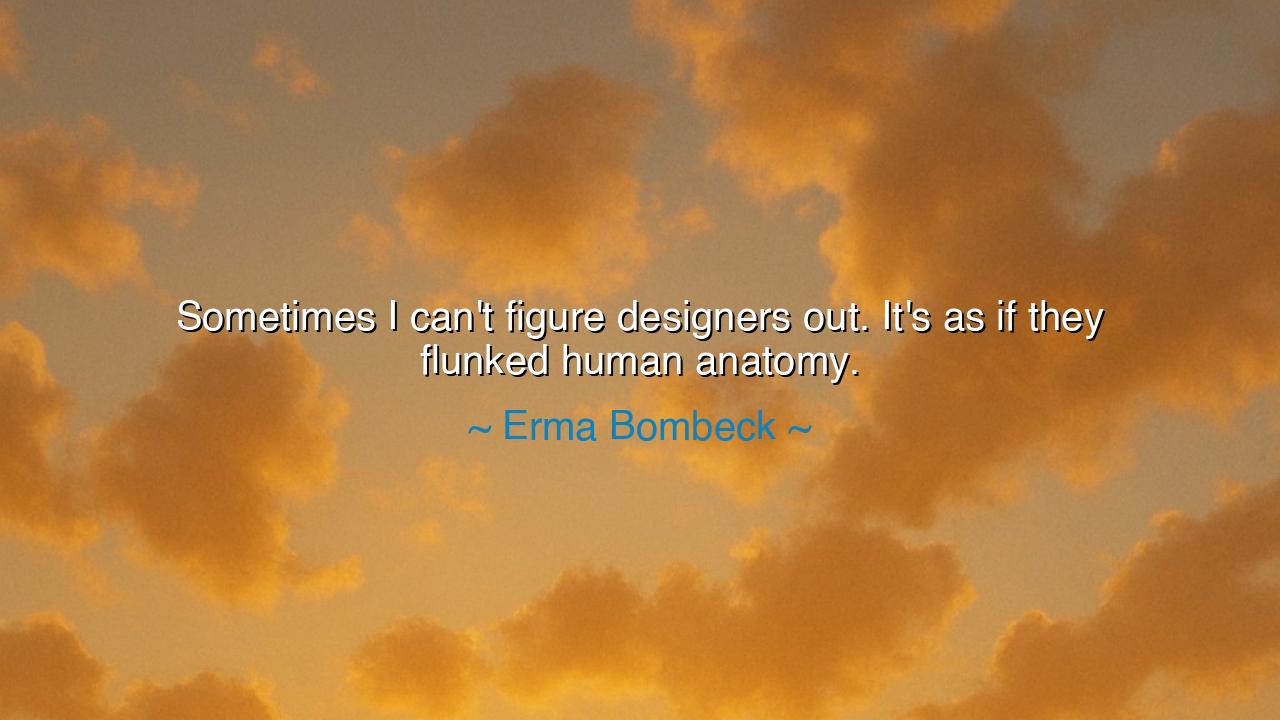
Sometimes I can't figure designers out. It's as if they flunked






The sharp-witted observer of human life, Erma Bombeck, once said with her characteristic blend of humor and truth: “Sometimes I can’t figure designers out. It’s as if they flunked human anatomy.” In this remark, cloaked in jest but rooted in wisdom, Bombeck strikes at a timeless truth — that design, whether of clothes, objects, or spaces, must serve the human being, not merely the designer’s vanity. Her words remind us that creation divorced from compassion, form divorced from function, and beauty divorced from comfort, lose their purpose entirely. The body — its movement, its dignity, its ease — is the first law of design. To ignore it is to betray both craft and humanity.
To understand the depth of Bombeck’s humor, we must see her world. She lived in an age of modern abundance, when new inventions and fashions poured endlessly into the lives of ordinary people. But beneath the glitter of progress, she saw a growing absurdity — objects designed for admiration rather than use, clothes that dazzled the eye but tortured the wearer. Her wit cut through the pretense: what use is a chair that cannot be sat upon, a dress that forbids movement, or a shoe that cripples the foot in the name of elegance? In saying designers had “flunked human anatomy,” she pointed to a failure not of skill, but of empathy — a forgetfulness that design exists not for display, but for life.
The ancients, in their wisdom, would have understood her lament. Vitruvius, the Roman architect, taught that all good design must rest upon three pillars: firmitas, utilitas, and venustas — strength, usefulness, and beauty. He placed usefulness in the very heart of his triad, knowing that beauty without utility is fragile and false. The Greeks carved statues that celebrated the perfect balance of human proportion, not to worship form for its own sake, but to honor the divine harmony of body and spirit. Even the builders of temples studied the measure of the human hand and foot, for they knew that design begins with the body — its needs, its grace, its rhythm.
Yet across the ages, there have always been those who forget this sacred relationship. Consider the fashion of the Victorian corset, which bound women so tightly that fainting became a social art. Or the pointed shoes of the medieval nobleman, so elongated they required special chains to walk. These were not expressions of design’s triumph, but its decay — moments when the maker’s ego rose higher than the needs of those they served. Bombeck’s humor, though born in the modern world, speaks with the same ancient authority: when creation ceases to respect the human form, it ceases to be creation at all — it becomes a kind of mockery.
Her insight extends beyond clothing and furniture; it touches the very heart of how we build our world. Too often, we design our technologies, our systems, even our cities, without remembering the human body and spirit that must live within them. We chase innovation and spectacle, forgetting comfort, warmth, and understanding. The irony Bombeck reveals is not only that some designers forget anatomy, but that entire societies sometimes do — designing lives that no longer fit the shape of the people who live them. Her laughter, then, is a kind of mercy — a wake-up call disguised as wit.
But from this humor, we draw a powerful lesson. The designer, in truth, is a guardian of empathy. Whether one crafts a chair, a garment, or an idea, the first duty is to know those who will use it — their limitations, their joys, their movements, their hearts. The wise designer studies not only materials, but people. He shapes with compassion as much as with precision, remembering that comfort, dignity, and humanity are themselves forms of beauty. To forget this is to “flunk anatomy” — not in ignorance of bones and muscles, but in ignorance of what makes us truly human.
So, my listener of the future, let the humor of Erma Bombeck become your wisdom. Whatever you design — a home, a relationship, a career, or a life — let it fit the shape of the human heart. Make it livable, not ostentatious; warm, not pretentious. Before you ask, “Is it beautiful?” ask first, “Is it kind?” For beauty without kindness is cruelty in disguise, and elegance without empathy is emptiness.
In the end, Bombeck’s jest is a truth as enduring as any philosophy: design must serve life. The human form — fragile yet magnificent — is the measure of all creation. When we honor it, our designs, our works, even our lives, find harmony. When we forget it, no symmetry or color can redeem the loss. Thus, let all who create remember: to design for the body is to respect its grace, but to design for the human being — body, mind, and soul — is to honor the divine.






AAdministratorAdministrator
Welcome, honored guests. Please leave a comment, we will respond soon